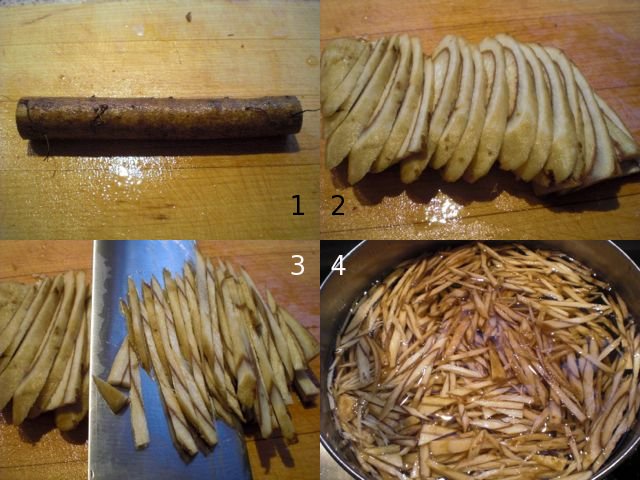This one is a non-traditional preparation of gobou salad dressed with mayonnaise and yogurt. There are quite a few variations of gobou salad recipe. Mine is an amalgamation of several recipes. Beside gobou, you can add other veggies such as carrot, diakon sprout, scallion, edamame, etc. Although optional, you can also add some type of protein such as ham, canned tuna, Spam (God forbid!), omelet (julienned to match the shape and size of the burdock). I used julienned roasted pork tenderloin, carrot and cucumber.

Gobou: I used half of the gobou root. The way I prepare gobou (for this dish and Kinpira) is shown below. Gobou is very slender and long (3-3.5 feet) and a bit unwieldy. So, I cut gobou in 10 inch segments (#1). Under running water, I scraped off the dark skin using the back of my "nakiri" knife 菜切り包丁 or vegetable cleaver. Then I sliced it rather thinly on a slant and lined them up overlapping (#2). Depending on if you are right or left handed, the direction of layering had to be changed.

While I was holding (with pressure) the burdock slices at the 1 inch or so on the left side of the blade (since the slices are properly layered, the portion the knife was cutting would stay put. When the knife blade came very close to my fingers holding the slices of burdock, I stopped and moved my fingers to one inch further to the left and continues (#3, I did not have a photographer - my wife- available, so I could not take a picture in action). The julienned burdock was promptly soaked in acidulated water (#4). I soaked it or 5-10 minutes and washed it in cold running water and drained.
Carrot: I sliced and julienned carrot similar to the way I prepared burdock (1 small).
First dressing: I cooked burdock and carrot in salted boiling water with a dash of rice vinegar for 3-4 minutes. I then drained and mixed in the first dressing while it was hot (to add "shita-aji" 下味 or base flavor) consisting of rice vinegar (1 tbs), olive oil (1.5 tbs) seasoned with salt and pepper. I let it cool in the dressing to room temperature.
Meanwhile I prepared the pork and cucumber.
Carrot: I sliced and julienned carrot similar to the way I prepared burdock (1 small).
First dressing: I cooked burdock and carrot in salted boiling water with a dash of rice vinegar for 3-4 minutes. I then drained and mixed in the first dressing while it was hot (to add "shita-aji" 下味 or base flavor) consisting of rice vinegar (1 tbs), olive oil (1.5 tbs) seasoned with salt and pepper. I let it cool in the dressing to room temperature.
Meanwhile I prepared the pork and cucumber.
Pork: This was leftover roasted prok tenderloin, about 2 inch long (the dry rub consisting of black pepper, smoked paprika, cumin, cinnamon, clove, and salt) and rosted at 350F for 30 minutes, sliced and then julienned.
Cucumber: My usual American minicucu (1 ), sliced and then julienned. I salted and squeezed out the excess moistre.
Final dressing: I drained any excess liquid/the first dressing from the burdock mixture and dressed. The final dressing is a mixture of store bought mayonnaise (1.5 tbs) and plain yogurt (1 tbs) (this makes the mayo a bit less deadly). After tasting, I added more black pepper but no salt.
I set asided a small portion of the julienne of the pork and cucumber for garnish.
This is a dish which goes well with wine. The cookbook I have, called "Japanese Dishes for Wine Lovers" has their version of gobou salad and the recommeded wines are Beaujolais or Chion. Since I am not a big fan of "light" reds, I will go with more heavy reds like syrah or cab but even assertive white like oaky California Chardonnay will also work.
Actually, we were having this with an excellent and very unusual red from Douro, Portugal called Quinta Do Crasto 2009. The grapes used in this wine are supposedly from 70 year old low yielding vines of many different grape varietals. WA gave 94 and WE 93. It is difficult to describe this wine but it is the likes of Orin Swift approach of everything but kitchen sink. I don't know how they can manage "field" selection of "20-30 different grapes" to come up with this well balanced red.
Like Xmas, cherry blossom occurs only once a year. And as my wife's grandmother used to say, "There is nothing more over than Christmas", so with hanami. So, until next spring, we have to wait.










